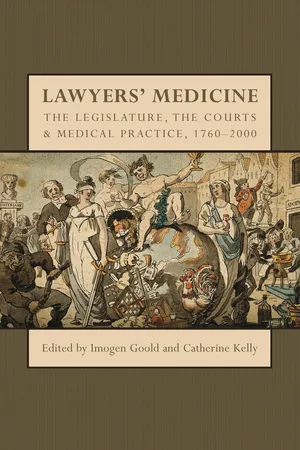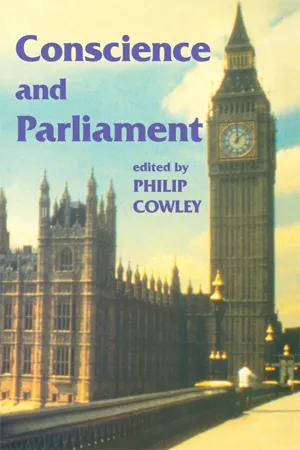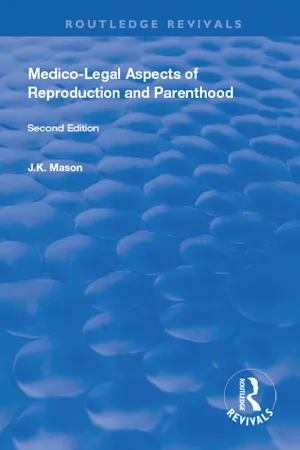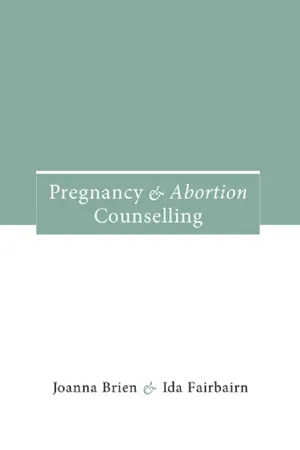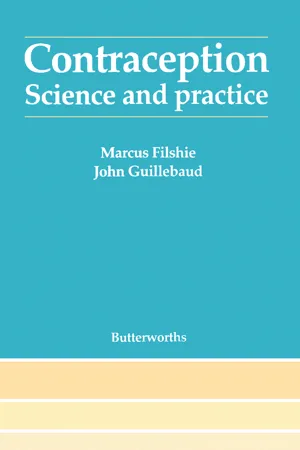History
Abortion Act 1967
The Abortion Act 1967 is a piece of legislation in the United Kingdom that legalized abortion under certain conditions. It allows for abortions to be performed by registered practitioners in National Health Service hospitals or licensed clinics. The Act sets out specific criteria for when an abortion can be carried out, including the need for two doctors to agree that continuing the pregnancy would risk the physical or mental health of the woman.
Written by Perlego with AI-assistance
Related key terms
1 of 5
10 Key excerpts on "Abortion Act 1967"
- eBook - ePub
- Claudia Carr(Author)
- 2014(Publication Date)
- Routledge(Publisher)
The case establishes that in common law, the restrictive statutory provisions against abortion could be circumvented in the case of necessity. This was, however, the exception rather than the norm. In any event, the defence is largely irrelevant in modern-day medicine as the defence of necessity is embodied in the most significant legislation – the Abortion Act 1967.9.1.6 The Abortion Act 1967The 1960s witnessed a general period of social and sexual enlightenment. One significant breakthrough in this decade was the introduction of the contraceptive pill. At a similar time there came an awareness that legislation was necessary to avoid the occurrence of ‘back street abortions’ where, to avoid falling foul of the law or the stigma that was still associated with abortions, patients either attempted self-abortion using archaic and gruesome methods, or abortions were carried out in often insanitary conditions, leaving the patients exposed and vulnerable to infection or even physical injury.The Abortion Law Reform Association was formed in 1936, shortly before the case of R v Bourne (1939), in order to address such social injustice. Backbencher Liberal MP David Steel introduced the Medical Termination of Pregnancy Bill, which later became the Abortion Act and was enacted in April 1968. The Bill was fiercely debated and was highly controversial, facing stiff opposition from religious groups. The issue of abortion remains as controversial today as when it was first before Parliament.The Abortion Act 1967 should probably be regarded in a similar way to the Sexual Offences Act 1967, which, in a more liberalised period, legalised homosexual relationships between two consenting males over the age of 21 in private. Of course, the provision is still restrictive according to modern-day standards, but each statutory provision should be considered in relation to the social standards prevailing at the time.The Abortion Act 1967 is drafted widely and many would argue somewhat liberally. It is only in force in England, Wales and Scotland. While abortion was now permitted, it is argued that the circumstances in which a termination of pregnancy can be performed lacks legal clarity for medical professionals and prospective patients alike, although Keown (1988) dispels this point of view by suggesting that the judgment in Bourne - eBook - PDF
Lawyers' Medicine
The Legislature, the Courts and Medical Practice, 1760-2000
- Imogen Goold, Catherine Kelly, Imogen Goold, Catherine Kelly(Authors)
- 2009(Publication Date)
- Hart Publishing(Publisher)
8 The Medical Community and Abortion Law Reform: Scotland in National Context, c 1960–1980 GAYLE DAVIS * This chapter will focus on the 1967 Abortion Act, which arguably constituted one of the most significant and contentious medico-social legislative developments of the 20th century within the British context. This Act was the first piece of abortion-related legislation to cover Scotland, England and Wales collectively, and brought the British medical profession much more fully into the arena of termination of pregnancy. The Abortion Act made termination legal where the risk to the life of a pregnant woman, or injury to her physical or mental health, or to that of her existing children, was greater than the risks from abortion, or where there was a substantial risk that a baby would be born seriously handicapped. 1 The history of abortion law reform has attracted fairly substantial academic attention. Broadly speaking, historians of sexuality have analysed the 1967 Act as part of the general programme of so-called ‘permissive’ measures introduced to Britain during the 1960s, including the partial decriminalisation of homosexual-ity and the easing of access to contraception, which redefined the relationship of the State to the moral domain of the private citizen. 2 Other commentators have focused on the social politics surrounding the genesis of the Abortion Act and subsequent attempts to restrict or overturn that legislation. 3 A final group has * This research was undertaken with the generous financial support of the Wellcome Trust (Grant 061152/Z/OO/Z/JM/HH/SW) and the generous intellectual support of the grant holder, Professor Roger Davidson. I would also like to acknowledge with gratitude the archival assistance I received from Lesley Hall, Fiona Watson, and the staff of the National Archives of Scotland. - eBook - ePub
- Philip Cowley(Author)
- 2012(Publication Date)
- Routledge(Publisher)
Abortion
SUSAN MILLNS and SALLY SHELDONA BORTION was partially decriminalised in Britain by the Abortion Act 1967, following many years of attempted reform.1 Since then, the regime established by that statute has been the subject of repeated challenges in the Houses of Parliament. This chapter first briefly sketches the regulation of abortion in England and Wales up to, and including, the Abortion Act 1967, before going on to discuss the various attempts to amend it over the years and the reforms eventually introduced in 1990 by section 37 of the Human Fertilisation and Embryology Act.2 It ends with some discussion of abortion as a political issue in the 1990s.THE LEAD-UP TO THE Abortion Act 1967
Originally an offence at common law, abortion was not criminalised by legislation until 1803. Prior to this date a distinction was made regarding the time at which a pregnancy was terminated. Where this occurred before quickening (the stage when the foetus first became animated and could be felt by the woman) no crime was committed. After quickening, termination of pregnancy became a criminal offence. Lord Ellenborough's Act of 1803 criminalised abortion and attempts to procure abortion at any stage of pregnancy, but with a harsher penalty being attached to the offence if committed after quickening. The distinction drawn at the quickening stage was later removed by legislation in 1837, which also put an end to the capital nature of the offence.Abortion was further regulated in 1861 by the introduction of the Offences Against the Person Act, which is still in force today. The relevant sections of the 1861 Act are sections 58 and 59, which state that it is an offence to procure a miscarriage or to supply the means of doing so. The statute makes no distinction between early and late abortion and contains no defence to this crime. Its harshness was mitigated by judicial interpretation: from 1938 until 1967 the provision of legal abortion in Britain was governed by the decision in R. v. Bourne.3 Alec Bourne, a surgeon of good reputation, openly performed an abortion on a teenage rape victim, without charging a fee. He was charged under section 58 with unlawfully procuring a miscarriage. The judge, Macnaghten J., directed that the word ‘unlawfully’ implied that there must also be certain circumstances in which abortion might be considered lawful. He advised the jury that the scope of lawful abortion would be equated with the scope of lawful child destruction under the Infant Life (Preservation) Act 1929. Thus, the jury were directed that in order for Bourne to be convicted the prosecution must prove beyond reasonable doubt that the operation was not performed ‘in good faith for the purpose only of preserving the life of the mother’. Preserving life was held also to include cases where ‘the probable consequences of the continuance of the pregnancy will be to make the woman a physical or mental wreck’.4 - No longer available |Learn more
- J. K. Mason(Author)
- 2018(Publication Date)
- Routledge(Publisher)
The precise extent of the trade is unknown and unknowable; a typical estimate is that there were between 10 000 and 100 000 unlawful abortions each year in the United Kingdom in the early 1960s, but the breadth of the bracket testifies to its lack of authority. It is interesting to note that the largest annual number of deaths attributable to abortion in that era was given as 185 in the statistics of the Register General for England and Wales; in 1966, 62 persons were sent for jury trial under the Offences Against the Person Act, 1861, s.58 and, of these, 28 received sentences of imprisonment. 30 Nevertheless, a serious potential mortality and morbidity existed and a need was perceived for regulation and documentation of practice in an area of what is, essentially, social medicine or public health. The result was the Abortion Act 1967. The Abortion Act 1967 The Abortion Act 1967, which began its life with the far more appropriate title of the Medical Termination of Pregnancy Bill, has been under attack since it came into force. On the one hand, criticism has come from what has become known as the ‘pro-life’ movement, on the grounds that its terms are too liberal; on the other, it is said by the ‘pro-choice’ group to pay too little regard to the rights of women to control their own bodies and to place too much social power in the hands of the medical profession. The debate has, however, been conducted in a relatively calm atmosphere and the Act stood unmodified until 1990, when a number of significant amendments were introduced by the Human Fertilisation and Embryology Act. Several of these will be discussed in the text below - eBook - ePub
- Joanna Brien, Ida Fairbairn(Authors)
- 2003(Publication Date)
- Routledge(Publisher)
Chapter 3 Abortion: The Historical, Legal and Social ContextAbortion is a deeply emotive subject and has been the centre of many heartfelt campaigns, from those based on the belief that life from conception is sacred to those based on the belief that women should have absolute control over their own bodies.The deliberate ending of a pregnancy continues to be the ‘source of social and legal discord, moral uncertainty, medical and psychiatric confusion and personal anguish’ (Callaghan 1970:1). Opponents of abortion argue on moral, religious and even political grounds. Our personal belief is that the individual woman must come to her own decision, armed with all the relevant facts, and that she is entitled to help on the same basis as in any other situation where she seeks medical help that is freely available under the National Health Service.Abortion is the most frequently performed operation in Britain inside and outside the NHS. Abortion is not seen by us as removed from accessible contraceptive services or comprehensive sex education to promote sexual health. We argue against a split in contraceptive and abortion services and for their integration at all levels. In March 1993, the Faculty of Family Planning and Reproductive Health Care of the Royal College of Obstetricians and Gynaecologists was established. This educational body hopes to be able to oversee the effective integration of reproductive health care within all the related disciplines. The separation of genito-urinary, abortion, sterilization and contraceptive services is not logical. It can lead to unnecessary gaps and fails to provide a ‘one stop’ service for clients. - eBook - PDF
Contraception
Science and Practice
- Marcus Filshie, John Guillebaud(Authors)
- 2013(Publication Date)
- Butterworth-Heinemann(Publisher)
Some private hospitals are not allowed to perform day-case procedures, despite the government giving encouragement for day-case facilities in the National Health Service [17]. Abortion has been made legal in eastern Europe since the mid-fifties. However, it was subsequent to the 1967 Abortion Act that abortion laws in many western European countries were clarified such that abortions under various circumstances are permitted in most European countries. Effect of the Abortion Act in Britain Since the introduction of the 1967 Abortion Act all legal abortions have been documented. The number of cases has risen and has continued to rise until this date. In 1968 23 000 procedures were reported, and in 1987 198 000 procedures were reported. Although approximately one-third of these were performed on women from overseas, the figures represent a disappointment. Demographic trends from eastern Europe show that after a period of some 15-20 years following liberalization, the abortion numbers decline. This has not happened in England. The abortion rate, however, has not substantially altered, suggesting that numerically more females are available to become pregnant. In 1968 25% of all patients were aborted in the second trimester, and most had hysterotomies. In 1987 this went down to approximately 13%, showing an encouraging trend of having terminations of pregnancy performed earlier. Unfortunately, some patients who are referred for termination of pregnancy early do not obtain their abortions until late because of poor administrative communication [18]. Despite 20 years of the abortion law there is still an inequality in terms of the services which are provided. In the Tyneside area and the Devon area over 94% of all 254 Abortion abortions are performed within the National Health Service, whereas in Leicester- shire the figure is only 13% [19]. - eBook - PDF
Regulating Reproduction
Law, Technology and Autonomy
- Emily Jackson(Author)
- 2001(Publication Date)
- Hart Publishing(Publisher)
56 The abor-tion decision is one that must be made by the pregnant woman’s doctor and not by a third party. It now seems to be settled law in the UK that the pregnant woman’s sexual partner has no rights in relation to the fetus, 57 and the European Commission for Human Rights has described a British man’s appli-cation to prevent his wife’s abortion as “manifestly ill-founded”. 58 While in practice, of course, a woman’s decision to terminate a pregnancy is frequently made in consultation with her sexual partner, 59 respect for the pregnant woman’s bodily integrity is obviously incompatible with a third party being able to make a decision about her medical treatment. So, in addition to the role it played in legalisation in 1967, the medicalisation of abortion may then have helped to emasculate both the anti-abortion lobby and litigious putative fathers. But strategic reliance upon the neutralising impact The Law 83 54 David Alton, who believes abortion is immoral, said that “. . . sixty one years ago . . .there was no ultrasound scanning . . ., no electro-cardiograms for a fetus, and no appreciation of the com-plete sensory development of the unborn child” HC Deb Vol 171 Col 223 (24 April, 1990). David Steel, whose Private Member’s Bill became the Abortion Act 1967, cited a study which showed that 75% of gynaecologists supported a 24 week limit: “We are not entitled to case aside all these opin-ions as though they did not matter, or to pluck out of the air a figure that we think might be better” HC Deb Vol 171 Col 204 (24 April, 1990). 55 Since 1991, 24 men have approached the courts in order to attempt to prevent abortions tak-ing place. And anti-abortion pressures groups such as Life and SPUC have recently formed alliances with organisations such as Families Need Fathers (Nolan, 1998, pp. 219, 221). - eBook - ePub
The Official History of Criminal Justice in England and Wales
Volume I: The 'Liberal Hour'
- Paul Rock(Author)
- 2019(Publication Date)
- Routledge(Publisher)
The Times, 1 and 6 August 1962, eventually finding relief in Sweden.279 The Times, 20 August 1962.280 The Times, 13 September 1962.281 The Times, 6 November 1962.282 The Times, 12 November 1962.283 The Times, 15 November 1962.284 The Times, 19 November 1962.285 P. Darby (13 August 1964); ‘Legal abortion’, New Society.286 In Pioneers of Change: Interviews with people who made the 1967 Abortion Act possible, http://www.bpas.org/js/filemanager/files/abortion_pioneers.pdf , 15.287 Glanville Williams, 1911–1997, was called to the Bar in 1935, became reader in English law, professor of public law, and then Quain Professor of Jurisprudence in the University of London; and then, in 1955, he became a fellow of Jesus College Cambridge, until his death. In his celebrated The Sanctity of Life and the Criminal Law (Faber and Faber: London, 1958) he reviewed the philosophical arguments underpinning the law on contraception, sterilisation, artificial insemination, abortion, suicide, and euthanasia. (Based on the entry by J. Spencer in the Oxford Dictionary of National Biography, http://www.oxforddnb.com/view/article/66017 )288 Constitution adopted at the Annual General Meeting held on 21 November 1964, Abortion Law Reform Association papers at the Wellcome Institute for the History of Medicine.289 Madeline Simms in Pioneers of Change: Interviews with people who made the 1967 Abortion Act possible, http://www.bpas.org/js/filemanager/files/abortion_pioneers.pdf , 17.290 Abortion Law Reform Association Annual Report 1964–65, 1.291 - eBook - PDF
- G. Allwood, K. Wadia(Authors)
- 2009(Publication Date)
- Palgrave Macmillan(Publisher)
Historical context Abortion was made a criminal act by Article 317 of the Penal Code of 1810, but the law was rarely enforced and during the nineteenth century, the question of how to care for unwanted children was of more public 82 Abortion 83 concern than the illegality of abortion. Growing anxiety about popula- tion decline following the First World War stimulated public debate and prompted legal reform. The state regulation of abortion was justified in terms of population and the national interest, rather than religious or moral reasons (Stetson 1987: 56). Laws introduced in 1920 and 1923 made it illegal to induce an abortion by any means or to provide any information on contraception or abortion. Penalties were particularly harsh for members of the medical profession (Allison 1994: 224). The 1923 reform was intended to make these provisions easier to imple- ment, by downgrading abortion from a serious to a less serious offence, thereby removing the requirement of trial by popular jury. The prona- talists behind this reform hoped that judges would take a harsher view than juries, and this was indeed the case, although there was no accom- panying rise in the birth rate (Mossuz-Lavau 2002: 88). In 1939, penalties were increased for members of the medical profession caught perform- ing abortions and for repeat offenders. In 1941, abortion became a crime against the state (Mossuz-Lavau 2002: 90). At the Liberation, the laws passed under Vichy were repealed. A series of incentives to procreate were introduced by the state, taking the form of financial assistance and state approval. In 1945, De Gaulle asked young couples to provide him with ‘millions of beautiful babies’ (Allison 1994: 223–4). In 1955, abortion was legalised on medical grounds if the preg- nancy endangered the life of the mother, but remained illegal in all other circumstances. Illegal abortions continued to take place, and the number of convictions fell (Mossuz-Lavau 2002: 93). - eBook - PDF
- Bidyut Kumar, Zarko Alfirevic(Authors)
- 2016(Publication Date)
- Cambridge University Press(Publisher)
243 Termination of pregnancy Chapter Section 5 Abortion and the law in the UK The Abortion Act 1967[1] and Human Fertilisation and Embryology Act 1990[2] govern induced abortion in England, Scotland and Wales (UK). Compliance with the provisions of the Abortion Act 1967 creates a series of defences to the Offences against the Person Act 1861, Section 58, which prohibited the unlawful induction of a miscarriage and the Infant Life (Preservation Act) 1929, which prohibited abortion except where it was done in good faith for the purpose only of preserving the life of the woman. The Human Fertilisation and Embryology Act 1990 introduced a time limit on most abortions of 24 weeks of gestation, but permitted termination at any gestation on the grounds of serious fetal abnormality, Ground E (Section 1(1)(d) of the Abortion Act. Statutory grounds for induced abortion The grounds for abortion (A–G) are set out in Sections 1(1)(a)–(d) of the Abortion Act. (A) The continuance of the pregnancy would involve risk to the life of the pregnant woman greater than if the pregnancy were terminated: Abortion Act 1967 as amended, Section 1(1)(c). (B) The termination is necessary to prevent grave permanent injury to the physical or mental health of the pregnant woman: Section 1(1)(b). (C) The pregnancy has not exceeded its 24th week and the continuance of the pregnancy would involve risk, greater than if the pregnancy were terminated, of injury to the physical or mental health of the pregnant woman: Section 1(1)(a). (D) The pregnancy has not exceeded its 24th week and the continuance of the pregnancy would involve risk, greater than if the pregnancy were terminated, of injury to the physical or mental health of any existing child(ren) of the family of the pregnant woman: Section 1(1)(a). (E) There is a substantial risk that if the child were born it would suffer from such physical or mental abnormalities as to be seriously handicapped: Section 1(1)(d).
Index pages curate the most relevant extracts from our library of academic textbooks. They’ve been created using an in-house natural language model (NLM), each adding context and meaning to key research topics.

